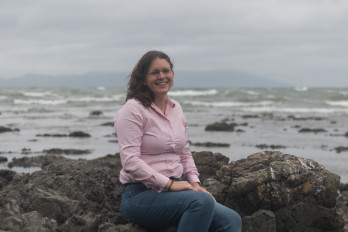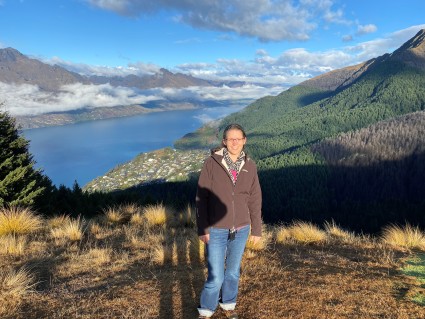Emily Townsend’s journey to where she is today spans multiple continents: from Kenya where she grew up, to the UK where she became a building materials expert, and now in New Zealand where she is working as a Life Cycle Assessment (LCA) and corporate carbon expert.
As the demand for life cycle thinking continues to grow rapidly, Emily will be highly influential in guiding companies through the LCA process and what comes after an LCA is completed in her new role as Head of Life Cycle Strategies.
We talk with Emily about her career — from her early LCA days with thinkstep-anz to becoming President of the Life Cycle Association of New Zealand — and look forward to her future as the Head of Life Cycle Strategies at thinkstep-anz. Emily shares how she accidentally found her way into sustainability roles after graduating from the University of Oxford with a degree in Chemistry, and imparts some advice for companies looking to take meaningful climate action.
You’ve been active in the field of sustainability for over a decade now. How did you enter your first sustainability role?
 My decision to study chemistry was out of passion and interest, not because I had a career in mind; I was interested in understanding how the world was built.
My decision to study chemistry was out of passion and interest, not because I had a career in mind; I was interested in understanding how the world was built.
I joined the building materials company Tarmac in the UK through their technical graduate scheme and became familiar with technical processes, materials, aggregates, and understanding how stuff works. It was a natural progression for me from the building blocks of Chemistry.
You can now study many aspects of sustainability, but I think for a lot of people I know, we ended up falling into the field.
I didn’t know a career in sustainability was a possibility when I first started at Tarmac, but I quickly got involved in two projects that exposed me to sustainability. And that is where it all started for me.
One project was a bid to provide materials to the 2012 London Olympics where there was going to be a big focus on sustainability. It was the best and also worst project because I was on my own with no safety net. It helped me to connect my experiences and where I’d come from with what I wanted to do — to have a purpose in life.
I also built Tarmac’s carbon footprint calculator which allowed us to calculate site and product-specific carbon footprints for our products. I got involved with the business development team so that we could start having conversations with clients about the different materials we could supply and their differences — not just in cost but also their carbon footprint. That project really stands out for me because it was one where I felt that I had really made a difference.
You have been with thinkstep-anz for just over three years now. Why did you choose thinkstep-anz and how has your role progressed?
I wanted to work on sustainability projects with companies that wanted to do sustainability.
I wanted to work with colleagues who understood what I did rather than be a ‘one woman sustainability team’.
I didn’t have the experience to go for it when I first came across thinkstep-anz, but I joined the committee of the Life Cycle Association of New Zealand (LCANZ). I told Barbara Nebel [founding President of LCANZ and CEO of thinkstep-anz] that I agreed to join in the hopes that one day there might be a role for me as a Life Cycle Assessment practitioner. And it worked, even at thinkstep-anz!
When I first started at thinkstep-anz, I was very much in learning mode. But I quickly got involved in quite a variety of projects and they have been eye-opening in different ways — learning about new industries, new companies, and delving deeper into sustainability.
My role has changed as my experience has grown and we’ve grown as a company. I have been supporting the company’s growth as a Team Lead and have moved into a project management role. And now, I’m transitioning again into my new title!
As the Head of Life Cycle Strategies, I will focus on how to help our clients plan what to do after we’ve completed the LCA or EPD for them. We will guide them on what they can do with the information, how to use it effectively, and how to gain the most value out of it.
It looks like your plan has worked on two levels, you also became the President of LCANZ. How has LCANZ evolved during your two years as President?
LCANZ was always popular with research and sustainability organisations, and industry groups with a big focus on technical best practice. In recent years, LCANZ has made a shift to also include supporting our wider LCA community in terms of how LCA can be used, integrated, and how it can complement other existing projects. Now there’s a lot of growth with businesses joining as they are starting to use LCA, publish their results, and want to talk about their experiences with other companies.
There is also change in the type of companies that go on to create Environmental Product Declarations (EPDs) with their LCA data. Initially, EPDs were popular with building products but now there is a drive for things like food products and clothing to have EPDs.
We are also moving away from using LCA to measure what we’ve already done and towards how we can improve things. The circular economy approach can certainly help to improve LCA in this area, just as LCA can support the move towards a more circular economy.
The link between circular economy and LCA is very clear to people who work in LCA, it may be less clear to people who work in circular economy.
As a Certified LCA practitioner, can you tell us what’s involved in the certification process? Why is it important for LCA practitioners?
In preparation for the three and a half hour, closed book exam, I studied the standards in detail to make sure I understood them because even experienced LCA practitioners struggle with the testing. The Life Cycle Assessment Certified Practitioner (LCACP) exam is important because it really does test your knowledge — not only of the basic principles and fundamentals of LCA but also the application of it.
You go through the LCACP process to check for yourself that you have the understanding of LCA that you hoped you would, and to prove to others that you do.
For almost two years, you were the Programme Manager for the Climate Leaders Coalition — the largest business-led organisation focused on climate action in NZ. What do you see as the role of CLC?
The role of the Climate Leaders Coalition is to engage with some of the biggest companies in New Zealand to hold them up as exemplars of what’s possible, what companies can commit to, but also to use their wider influence.
 If business doesn’t act, then there’s no chance of meeting any of our climate targets as a country or as a planet. CLC raises awareness of that and helps companies to understand the positive role they can play, and that they are in this together — it’s not a competitive thing.
If business doesn’t act, then there’s no chance of meeting any of our climate targets as a country or as a planet. CLC raises awareness of that and helps companies to understand the positive role they can play, and that they are in this together — it’s not a competitive thing.
For companies that aren’t meeting the targets, the CEOs and other signatories are asking them ‘Well, we’ve done this, why haven’t you?’.
If companies want to be part of the club that is the Coalition, then they need to deliver on their climate action commitments — whether it is meeting carbon reduction targets or having meaningful conversations with suppliers to reduce emissions collectively.
The next step is to raise the bar with the higher ambition 2019 pledge. One of the 2019 pledge statements puts the targets at the front and centre of the decision-making process for companies. A third of all signatories have signed up to the higher ambition pledge [as of June 2021]. Some have changed their initial target ambition, while others who have signed up for the first time have gone straight for the higher ambition pledge as they are also setting a science-based target for the first time.
What is your advice for organisations looking to take climate action seriously?
It depends on the organisations and what their main operations are — there is no one size fits all approach. The first thing I would recommend is to gain a better understanding of your own business and what the related impacts from what you do might be.
If you are in the business of making things then it is likely that your areas of high impact will be around your manufacturing facilities (the energy they use), and possibly also the materials you buy. Those will be the areas you want to focus on. An LCA or a product carbon footprint can help you look at those impacts.
On the other hand, if you are an office-based business then the areas of high impact are more likely to be your electricity use, and possibly business travel. A corporate carbon footprint can help you figure out where the hotspots are in your organisation.
Beyond that, the way you want to make change also matters — do you want to change your own impacts, work with your supply chain, or do both? So the first step is understanding your business and how you want to create change, then measure and understand your impacts, and create a plan to reduce them.
Why does sustainability matter to you personally?
From many different experiences, I’ve seen the negative ways in which we impact nature, wildlife, and climate change. I’ve also seen the positive ways in which we try to help preserve, protect, and sustain our environment. All of that has helped to shape me and my drive to improve things.
I grew up in Kenya and spent a lot of time camping with my parents in beautiful environments with diverse wildlife.
As a kid, I wasn’t aware of the negative impact humans had on natural environments, but I developed a love for the natural world that has carried into adulthood. Being outside is my safe space, it helps me to regenerate and so it became important to help preserve that.
What are the most sustainable and the most unsustainable things you’ve done in the last 12 months?

Emily on her first trip to Queenstown, 2021.
The least sustainable is probably business travel and a long weekend trip in Queenstown in the South Island. I want to explore this beautiful country I live in and it was my first time visiting the city, but I do still feel guilty about it.
I’m tweaking my diet and moving towards more plant-based foods. When my partner and I do eat meat or fish, we aim for higher quality, less quantity, and less often. We try to choose companies that are really driving their own sustainability practices like Silver Fern Farms (who we’ve done some work with) and some of the companies I’ve found through CLC and our own clients. I’ve also made the switch to Ethique, a vegan and plastic-free B Corp brand for beauty and lifestyle products. It started with just shampoo but now conditioner, moisturiser, face wash — everything is in solid form.